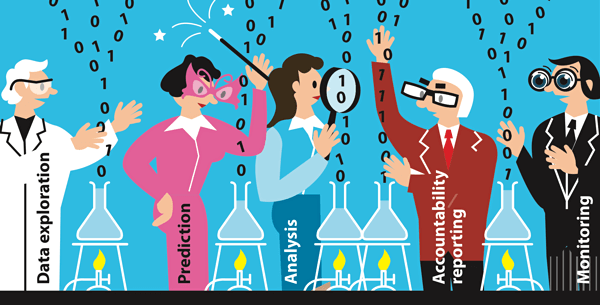The aim of an information request: information valorisation (2/5)
This article examines the aim of an information request: what are we going to do with all the information which is available in an organisation? A great deal of money is invested in information and data projects. That investment should lead to more added value in the operation. This is also true of information which is used for compulsory reporting to external regulators; the added value is then avoiding fines or damage to your image. Adding value to the operation doesn’t happen by itself, people need to make active use of the information. The process of adding value to the operation using information is called information valorisation.

Information valorisation is a broad concept. At the very minimum, it means that you don’t put any effort into information which doesn’t deliver any value and that you bid farewell to information which has proved to not deliver any substantial contribution.
What is a substantial contribution in information terms? That is difficult to define simply. It means, as a minimum, making use of information aimed at improving the way in which operational processes are carried out.
For example, you might use customer data and external user profile data to approach more and different customer groups, to improve the way in which the sales process is carried out. However, if you start servicing more and different customer groups, the delivery of your products and services will also have to connect to your sales process and your personnel process will also need to be able to provide the right people at the right time.
Managing connections is just as important as the way in which an individual process works. I use the abstract term operational process in this article, but you can replace this by the terms in your company’s environment.
Because information valorisation is a relatively intangible term, it is difficult to use it when making data and information projects concrete; information applications is a better way to proceed. How you use information to improve how the operational process is carried out, depends on which improvements you are aiming for. I’ve divided the data application into five use patterns.
Five use patterns for information
- Monitoring — Information is used to keep track of progress in an operational process while it is happening, so that immediate intervention is possible if progress stalls or if pre-defined norms are exceeded.
- Accountability reporting — Formal reporting about the results achieved by one or more operational processes. Often, the results are summed up over time and compared to a budget or target values. The best-known example of this kind of information product is the dashboard. The information is mainly used to evaluate whether an organisation is on course to achieve its targets. It is also used to analyse how and to what extent, management adjustments will be needed in the future, so that operational processes are carried out in a way that reach targets. It also checks whether these adjustments are realistic.
- Analysis — Analysing the achieved implementation of operational processes looking for explanations for unexpected outcomes. The information is used to structurally improve future implementations. These kinds of analyses are often referred to as ‘cause and effect’ analyses or ‘what if’ analyses.
- Prediction — Predicting the probable outcome of the future implementations of operational processes or the behaviour of actors in an operational process. Statistical and mathematical models, such as machine learning models, are used to build, validate or adjust predictive models using the available information.
- Data exploration — Browsing through data, looking for new insights. Various techniques are used for this, from visual inspection to statistics. The information is used to gain more insights into operational processes, the context within which operational processes are carried out, to discover or refine contexts, discover new opportunities and threats which lead to new or altered operational processes or for testing hypotheses. The results of the data research are mainly used to encourage discussions between people and to provide these discussions with direction and structure.
You might have noticed that I’m not using any terms such as business intelligence or big data. This is a conscious choice. The emphasis in these articles is on how the information is being used. The type of data which is being used to construct the information, the technology that is being used to put the information together and what you call it, has no impact whatsoever on how you use the information.
What does matter is who is involved in constructing the information and what that means for the interaction between people to arrive at information valorisation. The interaction model between information producers and information consumers differs according to the various use patterns. This interaction model is the subject of the next article in this series.
